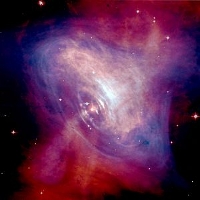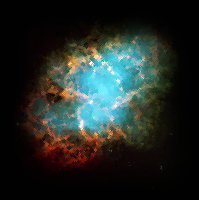
Torun Pulsar Group research interests
Scientific interests of our research group include mainly broad-band emission of pulsars at different evolutionary stages, and characteristics of pulsar wind nebulae (e.g. their morphology, physical and dynamical properties). In order to achieve our scientific goals we make use of rich observational material (analysis and interpretation of archival data and data obtained through different successful observational proposals), and of numerical codes that we develop in order to be able to predict and interpret results of observations.
PULSARS
 Pulsars (PSRs) are rapidly spinning, strongly magnetized
neutron stars radiating at the expense of their rotational energy. Such pulsars are called
rotation-powered pulsars, in contrast with pulsars for which the source of energy
is matter accreted from a companion star (such objects are called accretion-powered
pulsars). Currently, there are more than 1800 pulsars known (see
ATNF catalogue).
Radiation emitted by pulsars spans wide range of energies starting
from radio, through optical and X-rays, up to gamma-ray energies.
Pulsar radio emission is fascinating and poorly understood. Observational material
vastly dominates over the interpretive and predictive capability of existing theoretical
models. Radio pulsar spectra, profiles, polarisation, and multitude of single pulse
properties (nulling, drifting, mode-changing) all await a major break-through in our
understanding.
Our work focuses on understanding these enigmatic problems of pulsar emission. So far
we have addressed the following subjects:
- double notches (Dyks & Rudak 2012;
Dyks et al. 2010,
2007);
- rotational asymmetry of averaged profiles
(Dyks, Wright & Demorest 2010);
- altitude-dependent polarisation
(Dyks 2008);
- anticorellation between the main pulse and interpulse emission
(Dyks, Gil & Zhang 2005);
- emission altitudes from components' shifts
(Dyks, Rudak & Harding 2004);
- gamma-ray profiles and polarisation for radially-extended emission regions
(Dyks & Rudak 2003;
Dyks, Harding & Rudak 2004).
A new post-doc is welcome to join our group in efforts to interpret fascinating behaviour
of radio and gamma-ray pulsars.
Pulsars (PSRs) are rapidly spinning, strongly magnetized
neutron stars radiating at the expense of their rotational energy. Such pulsars are called
rotation-powered pulsars, in contrast with pulsars for which the source of energy
is matter accreted from a companion star (such objects are called accretion-powered
pulsars). Currently, there are more than 1800 pulsars known (see
ATNF catalogue).
Radiation emitted by pulsars spans wide range of energies starting
from radio, through optical and X-rays, up to gamma-ray energies.
Pulsar radio emission is fascinating and poorly understood. Observational material
vastly dominates over the interpretive and predictive capability of existing theoretical
models. Radio pulsar spectra, profiles, polarisation, and multitude of single pulse
properties (nulling, drifting, mode-changing) all await a major break-through in our
understanding.
Our work focuses on understanding these enigmatic problems of pulsar emission. So far
we have addressed the following subjects:
- double notches (Dyks & Rudak 2012;
Dyks et al. 2010,
2007);
- rotational asymmetry of averaged profiles
(Dyks, Wright & Demorest 2010);
- altitude-dependent polarisation
(Dyks 2008);
- anticorellation between the main pulse and interpulse emission
(Dyks, Gil & Zhang 2005);
- emission altitudes from components' shifts
(Dyks, Rudak & Harding 2004);
- gamma-ray profiles and polarisation for radially-extended emission regions
(Dyks & Rudak 2003;
Dyks, Harding & Rudak 2004).
A new post-doc is welcome to join our group in efforts to interpret fascinating behaviour
of radio and gamma-ray pulsars.
GLOBULAR CLUSTERS
 Globular clusters
(GCs) are a source of gamma-ray emission as identified by the
Fermi/LAT instrument. Their high energy emission
possibly extends up to TeV energies, where it can be detected with the Cherenkov
telescopes like H.E.S.S.
(see information on possible detection of Terzan 5).
This very energetic radiation can be attributed to population of millisecond pulsars,
which reside inside GCs. Cumulative gamma-ray emission of MSPs can explain spectra
of GCs below ~100GeV. Above this energy, scattering of ambient photon
fields (like CMB, or other background light) on relativistic particles permeating
environment of a cluster results in TeV photons. Interplay between these two scenarios
most probably explains observed gamma-ray emission of globular clusters.
Through numerical simulations we study the aforementioned scenarios of gamma-ray
emission of globular clusters.
Globular clusters
(GCs) are a source of gamma-ray emission as identified by the
Fermi/LAT instrument. Their high energy emission
possibly extends up to TeV energies, where it can be detected with the Cherenkov
telescopes like H.E.S.S.
(see information on possible detection of Terzan 5).
This very energetic radiation can be attributed to population of millisecond pulsars,
which reside inside GCs. Cumulative gamma-ray emission of MSPs can explain spectra
of GCs below ~100GeV. Above this energy, scattering of ambient photon
fields (like CMB, or other background light) on relativistic particles permeating
environment of a cluster results in TeV photons. Interplay between these two scenarios
most probably explains observed gamma-ray emission of globular clusters.
Through numerical simulations we study the aforementioned scenarios of gamma-ray
emission of globular clusters.
PULSAR WIND NEBULAE
 Pulsar wind nebulae
(PWNe) are bubbles filled with shocked relativistic particles injected
into surrounding environment by a pulsar through its relativistic magneto-hydrodynamic
wind. These particles (electrons and positrons) interact with nebular magnetic field
and radiate synchrotron emission across the electromagnetic spectrum. The first pulsar
wind nebula, the Crab Nebula powered by pulsar PSR B0531+21, was identified over 40 years
ago. Currently there are roughly 50 sources known, both in our own Galaxy and in
the Magellanic Clouds, with properties similar to those of the Crab Nebula.
In our research devoted to PWNe we are interested, in particular, in their infrared emission.
We study physical and dynamical properties of these objects through infrared
imaging, polarimetry and spectroscopy (see e.g.
Zajczyk et al. 2012, and
Mignani et al. 2012).
The infrared band is especially relevant for the cases of PWNe that suffer from high interstellar
extinction in the optical band.
Having access to the H.E.S.S. Cherenkov Telescope
(our group is an active member of the H.E.S.S. Collaboration) we also investigate properties
of PWNe at gamma-ray energies (energies above 100 GeV).
Pulsar wind nebulae
(PWNe) are bubbles filled with shocked relativistic particles injected
into surrounding environment by a pulsar through its relativistic magneto-hydrodynamic
wind. These particles (electrons and positrons) interact with nebular magnetic field
and radiate synchrotron emission across the electromagnetic spectrum. The first pulsar
wind nebula, the Crab Nebula powered by pulsar PSR B0531+21, was identified over 40 years
ago. Currently there are roughly 50 sources known, both in our own Galaxy and in
the Magellanic Clouds, with properties similar to those of the Crab Nebula.
In our research devoted to PWNe we are interested, in particular, in their infrared emission.
We study physical and dynamical properties of these objects through infrared
imaging, polarimetry and spectroscopy (see e.g.
Zajczyk et al. 2012, and
Mignani et al. 2012).
The infrared band is especially relevant for the cases of PWNe that suffer from high interstellar
extinction in the optical band.
Having access to the H.E.S.S. Cherenkov Telescope
(our group is an active member of the H.E.S.S. Collaboration) we also investigate properties
of PWNe at gamma-ray energies (energies above 100 GeV).
CHERENKOV TELESCOPE ARRAY
 Cherenkov Telescope Array (CTA)
is a future Cherenkov observatory that will consist of a large number of telescopes of different
sizes. Such construction will allow to perform observations at much better sensitivity
and at even lower energies than current Cherenkov telescopes.
Our group is an active member of the CTA
Collaboration.
Cherenkov Telescope Array (CTA)
is a future Cherenkov observatory that will consist of a large number of telescopes of different
sizes. Such construction will allow to perform observations at much better sensitivity
and at even lower energies than current Cherenkov telescopes.
Our group is an active member of the CTA
Collaboration.